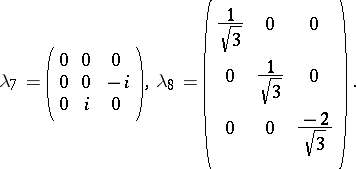Okubo algebra
Discovered by S. Okubo [a2] when searching for an algebraic structure to model  particle physics. Okubo looked for an algebra that is
particle physics. Okubo looked for an algebra that is  -dimensional over the complex numbers, power-associative and, unlike the octonion algebra, has the Lie algebra
-dimensional over the complex numbers, power-associative and, unlike the octonion algebra, has the Lie algebra  as both its derivation algebra and minus algebra. His algebra provides an important example of a division algebra that is
as both its derivation algebra and minus algebra. His algebra provides an important example of a division algebra that is  -dimensional over the real numbers with a norm permitting composition that is not alternative. For more information on these algebras, their generalizations and the physics, see [a3], [a5], [a4], [a7], and [a6].
-dimensional over the real numbers with a norm permitting composition that is not alternative. For more information on these algebras, their generalizations and the physics, see [a3], [a5], [a4], [a7], and [a6].
Following Okubo, [a7], let  be the set of all
be the set of all  traceless Hermitian matrices. The Okubo algebra
traceless Hermitian matrices. The Okubo algebra  is the vector space over the complex numbers spanned by the set
is the vector space over the complex numbers spanned by the set  with product
with product  defined by
defined by
 |
where  denotes the usual matrix product of
denotes the usual matrix product of  and
and  ,
,  is the trace of the matrix
is the trace of the matrix  (cf. also Trace of a square matrix) and the constants
(cf. also Trace of a square matrix) and the constants  and
and  satisfy
satisfy  , that is,
, that is,  . In the discussion below,
. In the discussion below,  . The algebra
. The algebra  is not a division algebra; however, it contains a division algebra. The real vector space spanned by the set
is not a division algebra; however, it contains a division algebra. The real vector space spanned by the set  is a subring
is a subring  of
of  under the product
under the product  and is a division algebra over the real numbers. Both the algebras
and is a division algebra over the real numbers. Both the algebras  and
and  are
are  -dimensional over their respective fields of scalars.
-dimensional over their respective fields of scalars.
An explicit construction of the algebra  can be given in terms of the following basis of
can be given in terms of the following basis of  traceless Hermitian matrices, introduced by M. Gell-Mann [a1]:
traceless Hermitian matrices, introduced by M. Gell-Mann [a1]:
 |
 |
 |
The elements  (
( ) form an orthonormal basis; the multiplication follows from
) form an orthonormal basis; the multiplication follows from
 |
The constants  and
and  must satisfy
must satisfy
 |
 |
A partial tabulation of the values of  and
and  can be found in [a1].
can be found in [a1].
The norm  of
of  is
is  . In the case of the algebra
. In the case of the algebra  , all the
, all the  are real and
are real and  if and only if
if and only if  .
.
The elements
 |
generate a  -dimensional subalgebra, denoted by
-dimensional subalgebra, denoted by  . Likewise, any non-identity element
. Likewise, any non-identity element  will generate a
will generate a  -dimensional subalgebra.
-dimensional subalgebra.
In addition to the above properties, each algebra will be flexible, power associative and Lie-admissible (cf. also Lie-admissible algebra; Algebra with associative powers); none of these algebras will have a unit element.
References
| [a1] | M. Gell–Mann, "Symmetries of baryons and mesons" Phys. Rev. , 125 (1962) pp. 1067–1084 |
| [a2] | S. Okubo, "Pseudo-quaternion and psuedo-octonion algebras" Hadronic J. , 1 (1978) pp. 1250–1278 |
| [a3] | S. Okubo, "Deformation of the Lie-admissible pseudo-octonion algebra into the octonion algebra" Hadronic J. , 1 (1978) pp. 1383–1431 |
| [a4] | S. Okubo, "Octonion as traceless  matrices via a flexible Lie-admissible algebra" Hadronic J. , 1 (1978) pp. 1432–1465 matrices via a flexible Lie-admissible algebra" Hadronic J. , 1 (1978) pp. 1432–1465 |
| [a5] | S. Okubo, "A generalization of Hurwitz theorem and flexible Lie-admissible algebras" Hadronic J. , 3 (1978) pp. 1–52 |
| [a6] | S. Okubo, H.C. Myung, "Some new classes of division algebras" J. Algebra , 67 (1980) pp. 479–490 |
| [a7] | S. Okubo, "Introduction to octonion and other non-associative algebras in physics" , Cambridge Univ. Press (1995) |
Okubo algebra. Encyclopedia of Mathematics. URL: http://encyclopediaofmath.org/index.php?title=Okubo_algebra&oldid=30357